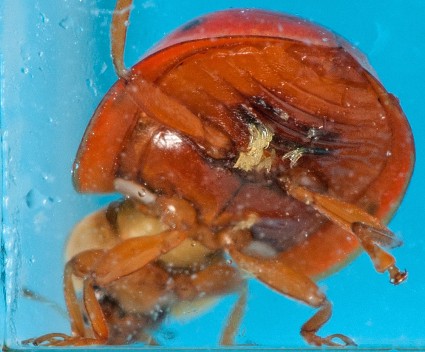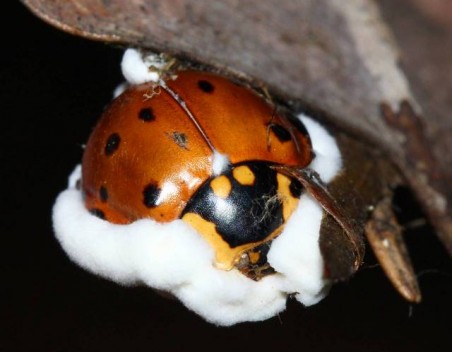Ladybug Fungi
I promise we will get to fungi, but first, let’s talk about ladybugs. There’s a new ladybug in town, and it’s not as charming and adorable as our old favorites. It’s the Multicolored Asian Ladybug, Harmonia axyridis. They were introduced to North America in the 20th century to eat pesky aphids: one ladybug can eat 200 aphids a day. This is really their most charming characteristic— their other attributes make them undesirable invasive insects (Koch 2003). They appear to be displacing friendlier native species (check out the Lost Ladybug Project). They have also become household pests, since they overwinter in huge aggregations on or in our houses. If you have them in your home this winter you know that if you piss them off, they produce a foul stink known as “ladybug taint.” If you’re a winemaker, ladybug taint can ruin a whole batch of wine if you accidentally squash some ladybugs along with your grapes. Even in low numbers they give wine the taste of rancid peanuts or rotten peas (Mansell 2009). Worse, ladybug allergy (that’s right, ladybug allergy!) is increasingly a problem for humans whose houses are ladybug overwintering sites (Goetz 2009). No laughing matter, and to top it all off, they sometimes bite. They’re just not very nice ladybugs.
 So, on to fungi. Today I present three: one friend of ladybugs; one foe; one just a nuisance. The nuisance is the coolest: Ladybugs don’t get fleas— but these labouls are the closest thing. They are blood-sipping parasites that form small colonies on the backs and bellies of ladybugs. With the naked eye they can be mistaken for plant pollen. Mordecai Cubitt Cooke, an early popularizer of fungi, dubbed them “Beetle Hangers” for their weird hook- or club-like appearance (Cooke 1892).
So, on to fungi. Today I present three: one friend of ladybugs; one foe; one just a nuisance. The nuisance is the coolest: Ladybugs don’t get fleas— but these labouls are the closest thing. They are blood-sipping parasites that form small colonies on the backs and bellies of ladybugs. With the naked eye they can be mistaken for plant pollen. Mordecai Cubitt Cooke, an early popularizer of fungi, dubbed them “Beetle Hangers” for their weird hook- or club-like appearance (Cooke 1892).
Beetle hangers belong to a diverse and surprisingly host-specific group of fungi, the Laboulbeniales. Of the 2000 described species an impressive 80% parasitize beetles, and many live only on a particular species of beetle. One of the first descriptions of this group was by Harvard’s Dr. Roland Thaxter. He did foundational work on the group, writing and illustrating a goliath five part series titled Contribution towards a monograph of the Laboulbeniaceae. Among the descriptions and illustrations that make up this work is Hesperomyces virescens, the green beetle hanger, which infects a variety of ladybugs.
A green beetle hanger’s entire life cycle takes place on a ladybug. The hard exoskeleton of insects seems unwelcoming, but beetle hangers are well suited for it. The life cycle begins with a spore that gets stuck to a ladybug. First the bottom cell of the spore, which will become the “foot,” grows until it penetrates the body of its host by creating a small gasket-like hole called an “o-ring” (Weir and Beakes 1996). Once inside, it grows a branched structure to absorb nutrients, like the roots of a tree. Its growth inside the ladybug is limited and causes little harm. Once the foot is firmly planted, the upper part of the spore grows to form male and female structures that allow it to reproduce. Ascospores made after fertilization are ejected by a trigger mechanism when touched— BANG! That’s how beetle hanger spores are spread among ladybugs, or to new parts of the same ladybug (Weir and Beakes 1996, Brodie 1978).

The green beetle hanger takes advantage of ladybugs’ gregarious and promiscuous behavior to get around. Female ladybugs can spread infection during matings with different males, and vice versa. Even encounters with infested deceased ladybugs can spread the fungus. Green beetle hangers spread easily among ladybugs overwintering in groups—infection can increase by as much as 40% (Nalepa and Weir 2007, Weir and Beakes 1996). Yet despite the probable discomfort and sometimes impairments to movement, most infected ladybugs lead full and happy lives (Weir and Beakes 1996, Brodie 1978).
While green beetle hangers may be irritating but harmless to ladybugs, another fungus of multicolored Asian ladybugs is actually beneficial. Multicolored Asian ladybugs are typically infected by parasitic fungi called microsporidia. Normally, microsporidia are disease organisms, but scientists were baffled to find them abundant in ladybug blood, causing no negative health impacts. On the contrary, it turns out they are a ladybug’s secret weapon: when native ladybugs eat microsporidia-infected eggs of multicolored Asian ladybugs they are essentially poisoned. The microsporidia may even be behind the antibacterial activity of their blood (Vilcinskas et. al 2013). By helping to eliminate native competitors these microsporidia contribute to their hosts’ success in taking over the world (Williams 2013, Vilcinskas et. al 2013).
Microsporidia are microscopic single-celled fungi. They are thought to have an ancient origin. Although microsporidia are widespread in animals and especially insects, with over 1200 known species, they are generally not good for health. For example, in immune compromised humans they cause a chronic disease called microsporidiosis. Incapable of reproducing outside of a host’s cells, they survive and are transmitted from cell to cell and animal to animal as egg-shaped spores. Once a spore makes contact with a host cell a long tube is ejected. It acts like a syringe to inject the microsporidium into its host. Once inside a host cell exploits its hosts cell machinery to make copies of itself, producing new spores that repeat the cycle.
 Now we’ve met a nuisance fungus and a helpful bioweapon, but every story needs a villain. If you’re sick of ladybugs getting into your wine and your house, here’s a fungus to kill them. Beauveria is a genus of molds that kills bugs. Various strains of Beauveria have been developed as biological controls of pest insects. Maybe we can find a strain perfect for killing off ladybugs who’ve overstayed their welcome, as Roy and colleagues (2008) suggest. These fungi don’t have to be injected or “inhaled,” they have the ability to drill their way into a ladybug and eat its insides (luckily they don’t eat me or you). Then they burst gloriously forth and grow the deceased ladybug a fuzzy white jacket.
Now we’ve met a nuisance fungus and a helpful bioweapon, but every story needs a villain. If you’re sick of ladybugs getting into your wine and your house, here’s a fungus to kill them. Beauveria is a genus of molds that kills bugs. Various strains of Beauveria have been developed as biological controls of pest insects. Maybe we can find a strain perfect for killing off ladybugs who’ve overstayed their welcome, as Roy and colleagues (2008) suggest. These fungi don’t have to be injected or “inhaled,” they have the ability to drill their way into a ladybug and eat its insides (luckily they don’t eat me or you). Then they burst gloriously forth and grow the deceased ladybug a fuzzy white jacket.
One ladybug: three different fungi, each adapted to live with its host in a different way. You can see why we think the world of insects will be a great place to discover a lot of fungal diversity.
Image Credits: Thanks to Claire Smith for the ladybug belly; Roland Thaxter for the green beetle hanger drawings; Alan Rockefeller for the Beauveria-swaddled ladybug.
References:
- Brodie, Harold J. (1978) Fungi, delight of curiosity. University of Toronto Press.
- Cooke, M.C. (1892) Vegetable wasps and plant worms: a popular history of entomogenous fungi, or fungi parasitic upon insects. Society for Promoting Christian Knowledge, 364p.
- Goetz, David W. 2009. Seasonal inhalant insect allergy: Harmonia axyridis ladybug. Current Opinion in Allergy and Clinical Immunology 9(4): 329–333. DOI: 10.1097/ACI.0b013e32832d5173
- Koch, R.L. (2003) The multicolored Asian lady beetle, Harmonia axyridis: A review of its biology, uses in biological control, and non-target impacts. Journal of Insect Science 3:32.
- Mansell, T. (2009) A rare and interesting wine fault: Ladybug taint. New York Cork Report.
- Nalepa, C.A. and A. Weir (2007) Infection of Harmonia axyridis (Coleoptera: Coccinellidae) by Hesperomyces virescens (Ascomycetes: Labouleniales): Role of mating status and aggregation behavior. Journal of Invertebrate Pathology. 94, 196-203.
- Roy, H.E., P.M.J. Brown, P. Rothery, R.L. Ware and M.E.N. Majerus (2008). Interactions between the fungal pathogen Beauveria bassiana and three species of coccinellid: Harmonia axyridis, Coccinella septempunctata and Adalia bipunctata. BioControl 53 (1): 265–276. doi:10.1007/s10526-007-9122-0
- R. Thaxter (1896). Contribution towards a monograph of the Laboulbeniaceae. I. Memoirs of the American Academy of Arts and Sciences 12: 187-429.
- Vilcinskas, A., K. Stoecker, H. Schmidtberg, C.R. Roehrich, and H. Vogel (2013) Invasive harlequin ladybird carries biological weapons against native competitors. Science (Washington D C), 340(6134), 862-863.
- Weir, A. and G.W. Beakes (1996) Correlative light- and scanning electron microscope studies on the developmental morphology of Hesperomyces virescens. Mycologia, 88(5), 677-693.
- Williams, R. (2013) Ladybird bioterrorists, the Asian harlequin ladybird carries a biological weapon to wipe out competing species. The Scientist.


I can’t wait to get these critters under the microscope next season…who knew?
[…] Ladybug Fungi at Cornell Mushroom Blog by Kathie Hodge […]
[…] ladybug fly away home. With 3 cool fungi. Megan Daniels looks at the […]
[…] They may be taking over the world, but […]